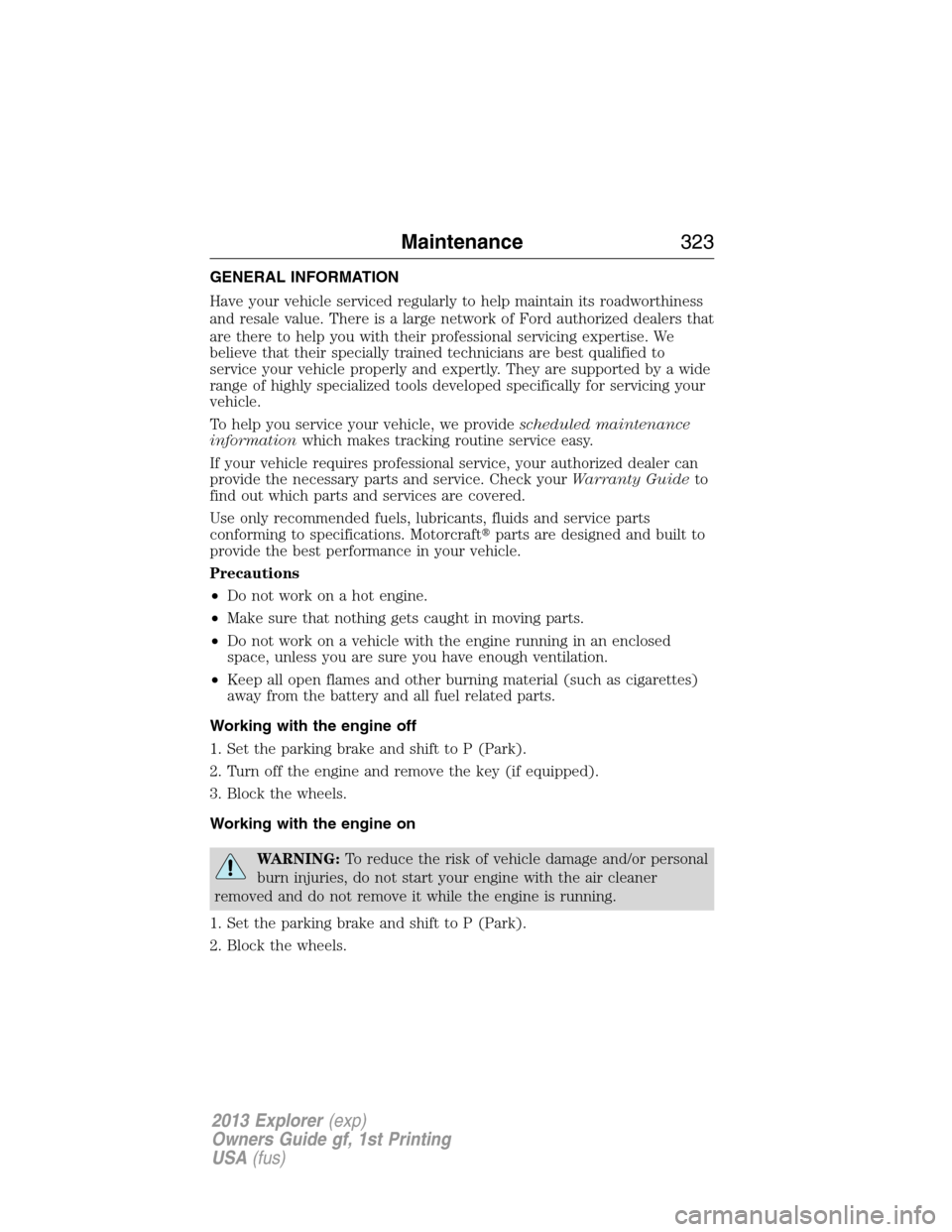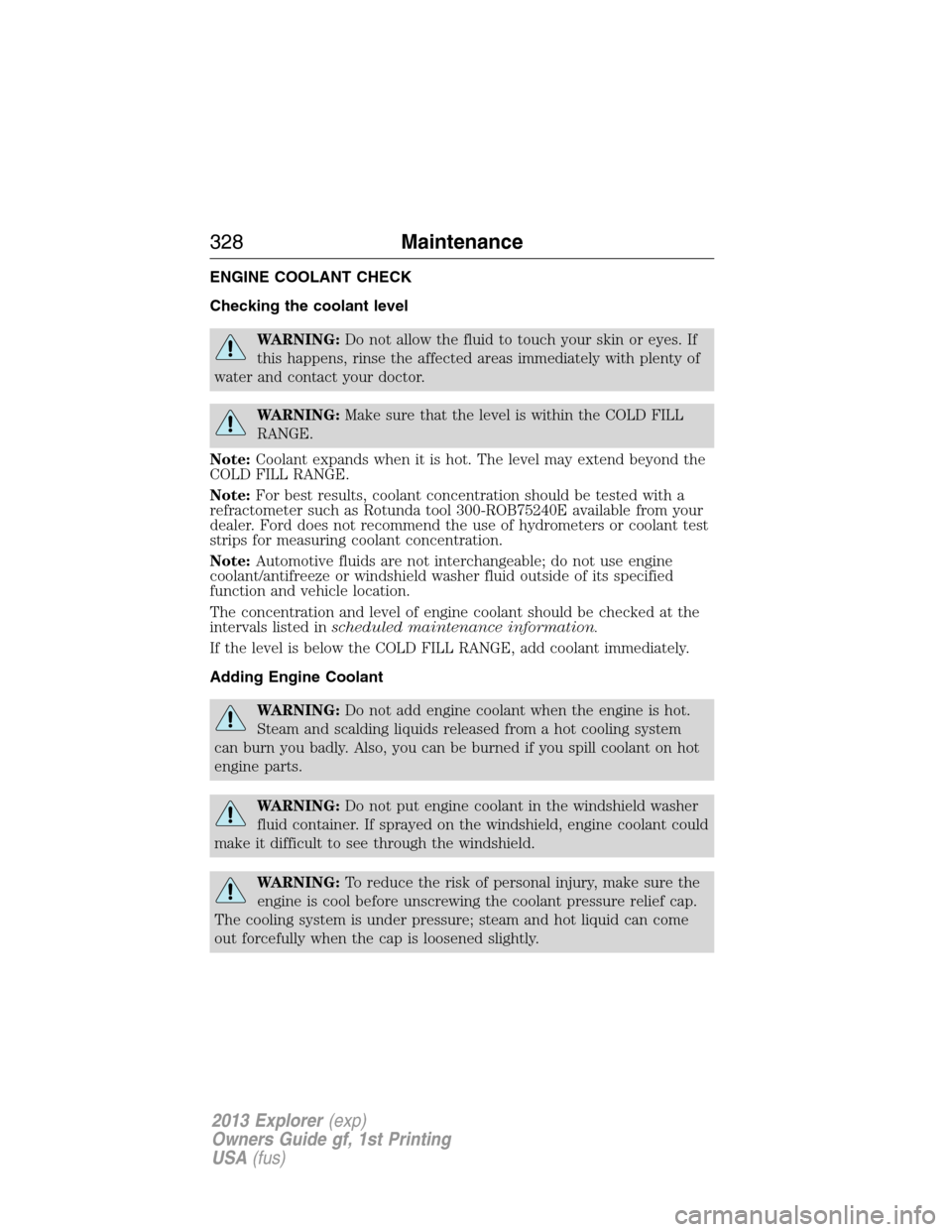Page 315 of 576
Fuse/Relay
NumberFuse Amp
RatingProtected Components
4 30A** Wipers, Front washer
5 50A** Anti-lock brake system (ABS)
pump
6 — Not used
7 30A** Power liftgate
8 20A** Moonroof
9 20A** Power point #2 (console rear)
10 — 3rd row rear seat release relay
11 — Rear window defroster relay
12 — Trailer tow battery charge relay
13 — Starter motor relay
14 — Engine cooling fan #2 high speed
relay
15 — Fuel pump relay
16 — Not used
17 40A** 110V AC powerpoint
18 40A** Front blower motor
19 30A** Starter motor
20 20A** Powerpoint #1/cigar lighter
21 20A** Powerpoint #3 (cargo area)
22 30A** 3rd row seat module
23 30A** Driver power seat, Memory
module
24 30A** Trailer tow (TT) battery charge
25 — Not used
26 40A** Rear window defroster, Heated
mirrors
27 20A** Powerpoint (console)
28 30A** Climate controlled seats
29 40A** Engine cooling fan #1 high speed
power, Engine cooling fan #1 and
#2 low speed primary fuse
Fuses315
2013 Explorer(exp)
Owners Guide gf, 1st Printing
USA(fus)
Page 316 of 576
Fuse/Relay
NumberFuse Amp
RatingProtected Components
30 40A** Engine cooling fan #2 high speed
fuse
31 25A** Engine cooling fan #1 and #2 low
speed secondary fuse
32 — Auxiliary blower motor relay
33 — Engine cooling fan #1 and #2 low
speed relay #2
34 — Blower motor relay
35 — Engine cooling fan #1 high speed
relay, Engine cooling fan #1 and
#2 low speed relay #1
36 — Not used
37 — TT right stop/turn lamps relay
38 — TT back up relay
39 40A** Auxiliary blower motor
40 — Not used
41 — Not used
42 30A** Passenger seat
43 40A** ABS valves
44 — Rear washer relay
45 5A* Rain sensor
46 — Not used
47 — Not used
48 — Not used
49 — Not used
50 15A* Heated mirrors
51 — Not used
52 — Not used
53 — TT left stop/turn lamps relay
54 — Not used
55 — Wiper relay
56 15A* Transmission control module
316Fuses
2013 Explorer(exp)
Owners Guide gf, 1st Printing
USA(fus)
Page 318 of 576
Fuse/Relay
NumberFuse Amp
RatingProtected Components
83 — Not used
84 20A* TT park lamps
85 — Not used
86 7.5A* PCM keep-alive power, PCM
relay, Canister vent solenoid
87 5A* Run/start relay coil
88 — Run/start relay
89 5A* Front blower relay coil, Electrical
Power Assist Steering (EPAS)
module
90 10A* PCM, TCM, ECM (2.0L engine)
91 10A* ACC
92 10A* ABS module, Plant EVAC and fill
93 5A* Rear blower motor, Rear
defroster, TT battery charge
relays
94 30A** Passenger compartment fuse
panel run/start
95 — Not used
96 — Not used
97 — Not used
98 — A/C clutch relay
*Mini Fuses **Cartridge Fuses
318Fuses
2013 Explorer(exp)
Owners Guide gf, 1st Printing
USA(fus)
Page 323 of 576

GENERAL INFORMATION
Have your vehicle serviced regularly to help maintain its roadworthiness
and resale value. There is a large network of Ford authorized dealers that
are there to help you with their professional servicing expertise. We
believe that their specially trained technicians are best qualified to
service your vehicle properly and expertly. They are supported by a wide
range of highly specialized tools developed specifically for servicing your
vehicle.
To help you service your vehicle, we providescheduled maintenance
informationwhich makes tracking routine service easy.
If your vehicle requires professional service, your authorized dealer can
provide the necessary parts and service. Check yourWarranty Guideto
find out which parts and services are covered.
Use only recommended fuels, lubricants, fluids and service parts
conforming to specifications. Motorcraft�parts are designed and built to
provide the best performance in your vehicle.
Precautions
•Do not work on a hot engine.
•Make sure that nothing gets caught in moving parts.
•Do not work on a vehicle with the engine running in an enclosed
space, unless you are sure you have enough ventilation.
•Keep all open flames and other burning material (such as cigarettes)
away from the battery and all fuel related parts.
Working with the engine off
1. Set the parking brake and shift to P (Park).
2. Turn off the engine and remove the key (if equipped).
3. Block the wheels.
Working with the engine on
WARNING:To reduce the risk of vehicle damage and/or personal
burn injuries, do not start your engine with the air cleaner
removed and do not remove it while the engine is running.
1. Set the parking brake and shift to P (Park).
2. Block the wheels.
Maintenance323
2013 Explorer(exp)
Owners Guide gf, 1st Printing
USA(fus)
Page 325 of 576
UNDER HOOD OVERVIEW
2.0L EcoBoost™ engine
A. Engine coolant reservoir
B. Brake fluid reservoir
C. Battery
D. Power distribution box
E. Air filter assembly
F. Engine oil filler cap
G. Engine oil dipstick
H. Windshield washer fluid reservoir
A
HGFE
BCD
Maintenance325
2013 Explorer(exp)
Owners Guide gf, 1st Printing
USA(fus)
Page 326 of 576
3.5L V6 engine
A. Engine coolant reservoir
B. Brake fluid reservoir
C. Battery
D. Power distribution box
E. Air filter assembly
F. Transmission fluid dipstick (out of view)
G. Engine oil dipstick
H. Engine oil filler cap
I. Windshield washer fluid reservoir
ABCD
EFGHI
326Maintenance
2013 Explorer(exp)
Owners Guide gf, 1st Printing
USA(fus)
Page 327 of 576

ENGINE OIL DIPSTICK
A.–MIN
B. – MAX
ENGINE OIL CHECK
Note:Check the level before starting the engine.
Note:Make sure that the level is between the MIN and MAX marks.
1. Make sure that your vehicle is on level ground.
2. Turn the engine off and wait 10 minutes for the oil to drain into the oil
pan.
3. Remove the dipstick and wipe it with a clean, lint-free cloth. Replace
the dipstick and remove it again to check the oil level.
If the level is at the MIN mark, add oil immediately.
Adding engine oil
Note:Do not remove the filler cap when the engine is running.
Note:Do not add engine oil further than the MAX mark. Oil levels above
the MAX mark may cause engine damage.
Only use oils certified for gasoline engines by the
American Petroleum Institute (API). An oil with this
trademark symbol conforms to the current engine and
emission system protection standards and fuel
economy requirements of the International Lubricant
Standardization and Approval Committee (ILSAC),
comprised of U.S. and Japanese automobile
manufacturers.
1. Remove the filler cap.
2. Add engine oil that meets Ford specifications. SeeCapacities and
Specificationsfor more information.
3. Replace the filler cap. Turn it until you feel a strong resistance.
Maintenance327
2013 Explorer(exp)
Owners Guide gf, 1st Printing
USA(fus)
Page 328 of 576

ENGINE COOLANT CHECK
Checking the coolant level
WARNING:Do not allow the fluid to touch your skin or eyes. If
this happens, rinse the affected areas immediately with plenty of
water and contact your doctor.
WARNING:Make sure that the level is within the COLD FILL
RANGE.
Note:Coolant expands when it is hot. The level may extend beyond the
COLD FILL RANGE.
Note:For best results, coolant concentration should be tested with a
refractometer such as Rotunda tool 300-ROB75240E available from your
dealer. Ford does not recommend the use of hydrometers or coolant test
strips for measuring coolant concentration.
Note:Automotive fluids are not interchangeable; do not use engine
coolant/antifreeze or windshield washer fluid outside of its specified
function and vehicle location.
The concentration and level of engine coolant should be checked at the
intervals listed inscheduled maintenance information.
If the level is below the COLD FILL RANGE, add coolant immediately.
Adding Engine Coolant
WARNING:Do not add engine coolant when the engine is hot.
Steam and scalding liquids released from a hot cooling system
can burn you badly. Also, you can be burned if you spill coolant on hot
engine parts.
WARNING:Do not put engine coolant in the windshield washer
fluid container. If sprayed on the windshield, engine coolant could
make it difficult to see through the windshield.
WARNING:To reduce the risk of personal injury, make sure the
engine is cool before unscrewing the coolant pressure relief cap.
The cooling system is under pressure; steam and hot liquid can come
out forcefully when the cap is loosened slightly.
328Maintenance
2013 Explorer(exp)
Owners Guide gf, 1st Printing
USA(fus)